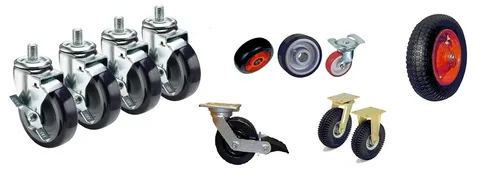Choosing the right castor wheel is essential to ensure smooth mobility, durability, and safety for your equipment. Whether you are outfitting industrial machinery, office furniture, or medical devices, selecting the appropriate castor wheels can significantly impact performance and longevity. This article will guide you on how to choose the right castor wheel for your equipment by examining the key factors to consider.
Understanding the Basics of Castor Wheels
Castor wheels come in various materials, sizes, and designs, each suited for different types of equipment and environments. The primary role of a castor wheel is to allow smooth and easy movement while supporting the weight of the equipment. To make an informed decision, it is important to know the basic types of castor wheels:
- Rigid Castors: Fixed direction wheels, suitable for straight-line movement.
- Swivel Castors: Rotate 360 degrees for maneuverability in tight spaces.
- Locking Castors: Include a brake system to hold equipment in place when needed.
Factors to Consider When Choosing Castor Wheels
1. Load Capacity
One of the most crucial factors in how to choose the right castor wheel for your equipment is understanding the load capacity. Each castor wheel has a maximum weight it can safely support. Overloading can lead to premature wear and failure. Calculate the total weight of the equipment, including any additional loads it might carry, and select wheels that can handle at least 25% more than that weight.
2. Wheel Material
The wheel material affects durability, noise, and floor protection. Common materials include:
- Rubber: Quiet, good for sensitive floors.
- Polyurethane: Durable and resistant to chemicals, ideal for industrial use.
- Nylon: Hard, durable, and suitable for smooth floors.
- Cast Iron or Steel: Heavy-duty and suitable for rough surfaces but can damage floors.
Selecting the correct material based on the environment and floor type is vital in how to choose the right castor wheel for your equipment.
3. Floor Surface and Environment
Consider the type of floor where the equipment will be used. Rough concrete requires different wheels compared to smooth tile or carpeted floors. Additionally, factors like exposure to moisture, chemicals, or extreme temperatures should influence your choice.
4. Wheel Size and Design
Larger wheels roll more easily over obstacles and uneven surfaces. The design, such as pneumatic or solid wheels, also affects mobility. Choose a size and style that matches the operational environment.
Additional Features to Look For
- Swivel vs. Rigid: Swivel wheels offer more maneuverability, while rigid wheels provide stability.
- Brake Systems: For safety and security, especially on inclined surfaces.
- Mounting Style: Plate, stem, or bolt hole mounts depending on your equipment.
Conclusion
Knowing how to choose the right castor wheel for your equipment involves assessing load requirements, floor conditions, wheel material, and size. Taking these factors into account ensures that your equipment moves efficiently, lasts longer, and operates safely. Whether for industrial machinery or everyday furniture, the right castor wheel makes all the difference.


